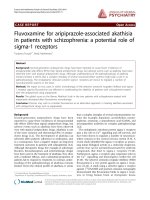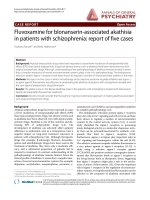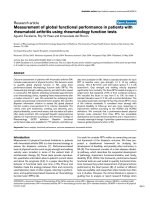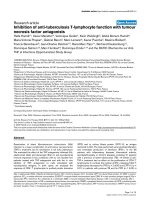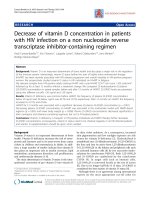Báo cáo y học: "FNH-like nodules: Possible precursor lesions in patients with focal nodular hyperplasia (FNH)" pdf
Bạn đang xem bản rút gọn của tài liệu. Xem và tải ngay bản đầy đủ của tài liệu tại đây (1.34 MB, 11 trang )
Comparative Hepatology
BioMed Central
Open Access
Research
FNH-like nodules: Possible precursor lesions in patients with focal
nodular hyperplasia (FNH)
Sébastien Lepreux1, Christophe Laurent2, Charles Balabaud*3,4 and
Paulette Bioulac-Sage1,4
Address: 1Service d'Anatomie Pathologique, Hôpital Pellegrin, Bordeaux, France, 2Service de Chirurgie Digestive et de Transplantation Hépatique,
Hôpital St André, CHU Bordeaux, France, 3Service de Hépato-gastroentérologie, Hôpital St André, CHU Bordeaux, France and 4GREF/INSERM
E0362, Université Bordeaux 2, 146, rue Léo Saignat, 33076 Bordeaux Cedex, France
Email: Sébastien Lepreux - ; Christophe Laurent - ;
Charles Balabaud* - ; Paulette Bioulac-Sage -
* Corresponding author
Published: 26 June 2003
Comparative Hepatology 2003, 2:7
Received: 26 November 2002
Accepted: 26 June 2003
This article is available from: />© 2003 Lepreux et al; licensee BioMed Central Ltd. This is an Open Access article: verbatim copying and redistribution of this article are permitted in all
media for any purpose, provided this notice is preserved along with the article's original URL.
Abstract
Background: The typical lesion of focal nodular hyperplasia (FNH) is a benign tumor-like mass
characterized by hepatocytic nodules separated by fibrous bands. The solitary central artery with
high flow and the absent portal vein give the lesions their characteristic radiological appearance.
The great majority of cases seen in daily practice conform to the above description. Additional
small nodules (from 1-2 up to 15-20 mm in diameter) detected by imaging techniques or on
macroscopic examination may be difficult to identify as representing FNH if they lack the key
features of FNH as defined in larger lesions. The aim of this study was to characterize these small
nodules, and to compare their characteristics with those of typical lesions of FNH present in the
same specimens.
Results: Eight patients underwent hepatic resections for the removal of a mass lesion ("nodule")
diagnosed as: FNH (1 patient); nodules of unknown nature (5 patients); or nodules thought to be
adenoma or hepatocellular carcinoma (2 patients). Six nodules out of 9 discovered by imaging
techniques met histopathological criteria for the diagnosis of typical FNH, at least in parts of the
nodule; 2 nodules corresponded to a minor form of FNH ("subtle FNH") and one nodule to a
steatotic area. Although FNH was thought to be found in a normal or nearly normal liver, this study
revealed that, in addition, there were various types of small FNH-like nodules and vascular
abnormalities in the liver with typical FNH nodule. The various types of small FNH-like nodules (n
= 8, diameter 2 to 20 mm) consisted of the association to various degrees of numerous and/or
enlarged arteries in portal tracts or in septa, with hyperplastic foci, slight ductular reaction, and
regions of sinusoidal dilatation, accompanied by thin fibrous bands. Vascular abnormalities
consisted of unpaired arteries, portal tracts with arteries larger than the associated bile duct, and
regions of sinusoidal dilatation.
Conclusions: Although these small nodules can be considered as insufficient type or abortive
forms of FNH, or adenoma, they can be precursors of the large mass lesions in which FNH was
recognized and defined.
Page 1 of 11
(page number not for citation purposes)
Comparative Hepatology 2003, 2
/>
Background
Results
The typical lesion of focal nodular hyperplasia (FNH) is a
benign tumor-like mass characterized by hepatocytic nodules separated by fibrous bands. The mass has a central
stellate fibrous region containing malformed vascular
structures that include large arteries but, as a rule, without
portal veins. The component nodules consist of nearly
normal hepatocytes arranged in plates 1 to 2 cells thick. A
more or less prominent bile ductular reaction is usually
found at the interface between hepatocytes and fibrous
bands. It is thought that increased arterial flow [1,2]
hyperperfuses the local parenchyma leading to secondary
hepatocellular hyperplasia [3]. FNH is therefore considered a hyperplastic rather than a neoplastic process. The
solitary central artery with high flow and the absent portal
vein give the lesions their characteristic radiological
appearance [4–6].
The main relevant pathological data are presented in
Tables 1 and 2.
The great majority of cases seen in daily practice conform
to the above description [7]. Additional small nodules
(from 1–2 up to 15–20 mm in diameter) detected by
imaging techniques or on macroscopic examination may
be difficult to identify as representing FNH if they lack the
key features of FNH as defined in larger lesions.
The aim of this study was to characterize these small nodules, and to compare their characteristics with those of
typical lesions of FNH present in the same specimens.
Nine nodules were discovered by imaging techniques in
specimens resected from 8 patients. Eight were FNH: 4
typical, 1 typical and telangiectatic, and 3 either typical
steatotic or subtle FNH. One steatotic nodule was difficult
to classify (see below). None of the patients had multiple
lesions of typical FNH.
Eight additional small nodules were discovered during
slicing. Only one was a typical FNH (steatotic).
For didactic purposes, we arbitrarily classified these small
nodules into 5 types, from type 1 to type 5 (see Methods
for description of different types), referring to the typical
FNH lesion as type 5. Among the other small nodules, 3
being steatotic, 2 were classified as lesions of type 1 (Fig.
1), 2 as of types 2 (Fig. 2) and 3 lesions, and 2 as type 3
(Fig. 3) lesions, respectively; the seventh was classified as
type 2, 3, and 4 lesions (Figs. 4, 5).
The non-classified nodule detected by imaging techniques
(patient 1) corresponded to type 1–2 lesion. Both fullblown (Fig. 6a) and subtle FNH occasionally had type 2
or 3 lesions at their periphery (Fig. 6). A large hepatic vein
wall hypertrophy was occasionally observed in the vicinity of nodules (Fig. 1d).
Table 1: Data of nodules
Cases
Imaging techniques (results)
Total number of nodules (imaging +
slicing): size / aspect
1
a: 2.5 cm nodule (LL), FNH b: 1.5 cm adjacent triangular lesion c: not detected d: not
detected
a: 2.5 cm nodule (LL) probable adenoma
a: 2.5 cm, aspect of FNH b: 1.5 cm / yellow
c: 5 mm / yellow d: 2 mm / yellow
2
3
6
a: 6 cm nodule (RL), FNH or adenoma b:
not detected
a: 4 cm nodule (LL), probable adenoma b:
not detected
a: 3.5 cm nodule (III and IV), adenoma or
HCC b: not detected c: not detected d: not
detected
a: 3 cm nodule (VIII), adenoma or FNH
7
8
a: 7 cm nodule (V, VI), FNH b: not detected
a: 2 cm nodule (V, VI), suspicion of HCC
4
5
Histological diagnosis
a: FNH (typical) b: steatotic nodule (type 1–
2 lesion) c: steatotic nodule (type 2–3
lesion) d: steatotic nodule (type 2–3 lesion)
a: nodule difficult to identify from the sura: partly type 2–3 lesion, partly subtle FNH
rounding tissue
(type 4 lesion)
a: 6 cm, aspect of FNH b: 5 mm whitish nod- a: FNH (typical) b: dilatation of thin wall vesule
sels (type 1 lesion)
a: 4 cm, aspect of FNH b: 1 × 2 cm whitish
a: FNH (typical and telangiectatic type) b:
nodule
type 2, 3, 4 lesions
a: 3.5 cm, aspect of FNH b: 1.5 cm c: 3 mm a: FNH (typical but steatotic) b: FNH (typiyellow d: 2 mm hemorrhagic
cal but steatotic) c: type 3 lesions d: dilatation of thin wall vessels (type 1 lesion)
a: 3 cm, aspect of FNH
a: typical FNH with type 2–3 lesion at the
periphery
a: 7 cm, aspect of FNH b: 1.1 × 1.8 cm pale a: FNH (typical) b: steatotic (type 3 lesion)
a: 2 cm, aspect of FNH
a: subtle FNH (type 4 lesion) with type 2–3
lesion at the periphery
Cases 1 to 7 are women. Letters a, b, c, d identify different nodules for a same case. Roman numbers indicate the segments of the liver. LL: left lobe;
RL: right lobe.
Page 2 of 11
(page number not for citation purposes)
Comparative Hepatology 2003, 2
/>
Table 2: Data of cases
Cases
Age
Discovery
Other findings
Surgery
Pathological findings of non nodular liver
1
37
Abdominal pain
LH
2
49
Abdominal pain
Type 1 diabetes,
Hashimoto thyroiditis
Gallbladder lithiasis
3
35
Persistant rise in GGT
RH
4
39
Incidental (episode
of fever and rise in
transaminases)
Incidental
Some foci of steatotic and clear hepatocytes. Mildly enlarged
portal tracts with thickened arteries.
Micro and macro steatosis (30 %). Few foci of steatotic hepatocytes, some portal tracts with enlarged arteries.
Macrovesicular steatosis (15 %). Small and rare peliotic areas.
Accentuation of the lobular septation.
5
49
6
7
29
32
Follow up for
chronic alcoholism
Incidental
Abdominal pain
8
47
Abdominal pain
LH
LH
LH + IV
Hemangioma
VII
V, VI
V, VI
Macrovesicular steatosis (10 %). Small and rare peliotic areas.
Some portal tracts with enlarged arteries.
Severe steatosis (60 %). Few limited areas with dilated sinusoids
and peliosis. Often enlarged arteries.
Around nodule b, approximation of portal tracts, absence of
portal veins, thickened wall of hepatic veins, one steatotic focus.
Macrovesicular steatosis (50 %) medio/centro lobular.
Cases 1 to 7 are women. Roman numbers indicate the segments of the liver. GGT: gammaglutamyl transpeptidase; HCC: hepatocellular carcinoma:
LH: left hepatectomy; LL: left lobe; RL: right lobe.
Hyperplastic foci (Figs. 3, 5) in type 3 lesions were fed by
arterioles accompanied by slight changes of the ductular
reaction. These changes comprised anastomosing biliary
ductules with poorly defined lumina, lined by flattened
cells with scanty cytoplasm that in paraffin sections
marked strongly for cytokeratin (CK) 7 and failed to mark
or marked weakly for CK 19. A few small, single cells with
an ovoid nucleus and scanty cytoplasm, marking for CK7
but not for CK19 (possible "undifferentiated progenitor
cells"), were observed, as were intermediate cells, resembling hepatocytes, that marked faintly for CK7 (Fig. 3c).
Sinusoids sometimes expressed endothelial antigen
(CD34) and α-smooth muscle actin (α-SMA) (Figs.
3b,3d). Serial sections and CK7 immunostaining were
often required to identify the ductular reaction.
Cirrhotic-like nodules progressively tend to appear when
hyperplastic foci were separated by regions of sinusoidal
dilatation containing arterioles and/or areas of cellular
damage with necrosis, accompanied by thin fibrous bands
which tend to approximate neighboring hepatic veins (Fig
5) characterizing type 4 lesion (minor form of FNH, so
called "subtle FNH").
The non-nodular liver was grossly normal, although significant steatosis (> 30% of hepatocytes in sections) in 3
patients, including one addicted to alcohol. However,
careful microscopic examination revealed a few focal
abnormalities (Fig. 7): unpaired arteries, portal tracts with
arteries larger than the associated bile duct, steatotic foci,
and areas of sinusoidal dilatation or even peliosis.
Discussion
FNH is not a neoplasm but a nonspecific hyperplastic
reaction to vascular abnormalities [1,2]. Vascular abnormalities can be developmental or secondary and vary in
their distribution from focal to diffuse; leading to highly
varied clinical and pathological presentations [8,9].
However, there is no clear understanding as to how this
hyperplastic reaction gives rise to a kind of focal cirrhosis.
The origin of the bile ductular structures, one of the hallmarks of the diagnosis, is not definitely established. The
presence of "undifferentiated progenitor cells" in FNH
suggests that the ductular reaction in these lesions results,
at least partly, from activation of those cells [10]. If
fibrosis in FNH arises as an accompaniment of the ductular reaction [11], how this fibrosis encircles nodules
remains to be shown.
Since it is impossible to follow the growth of a given FNH
lesion by microscopy, we can only speculate how nodules
form. The histological criteria proposed to describe
lesions as type 1, 2, or 3 are compatible with a high arterial influx even for tiny nodules; indeed, they are in favour
of the diagnosis of small FNH-like lesions.
In addition, other arguments suggest that those small
FNH-like lesions could be precursor lesions of FNH. These
arguments are the following: the possible association of
FNH-like lesions with either classical criteria of FNH in
the same nodule (as in patient 6), or with typical FNH (in
the case of several nodules, 5 patients in this series), or
with hemangioma (one patient in this series).
Page 3 of 11
(page number not for citation purposes)
Comparative Hepatology 2003, 2
/>
a
b
HV
c
d
(a, b) Patient 1, nodule b: type 1 lesion
Figure 1
(a, b) Patient 1, nodule b: type 1 lesion. Small steatotic nodule with mildly disorganized lobular architecture; some small portal
tracts contain arteries unaccompanied by bile ducts. At higher magnification (box) (b), dilated thin-walled vessels adjoin a small
portal tract at the periphery of the nodule. H&E. (c) Patient 3, nodule b: type 1 lesion. Dilated vessels in and around small portal tracts near a large portal tract. Reticulin staining. (d) Patient 1: Non-lesional liver. A large hepatic vein with an irregularly
thickened wall lies near small portal tracts that contain numerous arterial cross-sections. Anti-α-SMA immunostaining
Small FNH (with in the center typical cirrhotic-like nodules) may be surrounded with type 1 and 2 lesions (Fig.
6). Furthermore, beyond the apparent limit of a lesion of
FNH, it was not rare to observe hyperplastic foci, as if
another rim was underway, all together suggesting that
growth was not completed. The possibility that these
changes could be a secondary effect, related to the tumoral
mass, cannot be ruled out but to us appears unlikely
because of the small size of the nodule.
Small nodules may be difficult to identify. When they
contain abnormal arteries (in size and/or number),
accompanied by occasional bile ducts and/or portal vein
branches, those arteries could represent the strongest and
earliest identifiable sign of FNH (type 2 lesions). This is in
accordance with the hypothesis of focal high arterial flow
as either a primary or secondary phenomenon. We
hypothesize that communication of arterioles with
various vessels (terminal portal vein branches, inlet
venules, even sinusoids) could lead to dilatation of the
Page 4 of 11
(page number not for citation purposes)
Comparative Hepatology 2003, 2
/>
a
a
b
c
d
(a, b, c,2 Patient 2, nodule a: type 2 lesion; all images represent the same region
Figure d)
(a, b, c, d) Patient 2, nodule a: type 2 lesion; all images represent the same region. Portal tracts (arrow) contain numerous
arterial cross-sections and bile ducts. There is no ductular reaction. Portal veins are not identified with certainty. a, H&E; b,
anti-α-SMA; c, anti-CK7; d, anti-CD34 immunostaining.
latter, a dilatation that we have sometimes observed as the
sole abnormality in some small nodules (type 1 lesions).
However, taking into account that the lesions of FNH are
usually stable, these FNH-like nodules could also be recognized as an insufficient type or abortive form of FNH.
We cannot ignore that not all nodules identified by imaging techniques or by the pathologist on macroscopy, are
typical FNH or even FNH-like nodule; they may represent
other lesions, including adenoma. Indeed, FNH has been
described in association with hepatocellular adenoma
[12–15] and with adenomatosis [16]. This association
raises difficult diagnostic and pathogenetic problems
[17], as mixed hyperplastic and adenomatous forms of
FNH have been described [8]. In our experience, particularly in adenomatosis, it is sometimes impossible to
identify with certainty whether some small nodules are
indeed FNH or adenomas. Additional studies using more
appropriate tools such as molecular techniques [18], as
well as careful follow-up studies, will be necessary to
resolve this issue.
An important observation made in this study was that the
coexistence of typical lesions of FNH with nodule that
resembled FNH was associated with vascular abnormali-
Page 5 of 11
(page number not for citation purposes)
Comparative Hepatology 2003, 2
/>
a
b
c
d
Figure 3d), Patient 2, nodule a: type 3 lesion (same nodule as in Fig 2, but another region)
(a, b, c,
(a, b, c, d), Patient 2, nodule a: type 3 lesion (same nodule as in Fig 2, but another region). This hyperplastic focus is surrounded with atrophic hepatocytes (a, b, d); arteries are seen at the periphery and inside the focus. A mild ductular reaction
along the axis of arterioles is visualized by anti-CK7 immunostaining (c). A few isolated biliary cells (large arrow) and intermediate hepatocytic cells (small arrow) immunostain. Note the presence (a, b, d) of large venules near small arteries. Most sinusoids are capillarized, as shown by expression of CD34 by sinusoidal endothelial cells (d). a, H&E; b, anti-α-SMA; c, anti-CK7; d,
anti-CD34 immunostaining.
ties in the non-nodular liver. It could indicate that both
the frank FNH and nodule that resemble FNH are the
visible part of a more diffuse pathological entity. FNH are
generally assumed to be rather stable, but this may not
apply to all small lesions. In at least one published
instance, new FNH appeared during the follow-up of a
patient who previously had a liver resection for FNH [19].
Finally, the hypertrophy of a large hepatic vein in the
vicinity of some nodules remains unexplained; we can
speculate that it could be related to the use of oral contra-
ceptives [20] or to abnormal arterial feeding of the vein
[21].
Conclusions
In keeping with the concept that in FNH increased arterial
flow [3] hyperperfuses the local parenchyma leading to
secondary hepatocellular hyperplasia, the presence of
nodules that contain numerous or enlarged arteries in
portal tracts or isolated arteries, associated with a focus of
hyperplastic hepatocytes, suggests that these nodules and
Page 6 of 11
(page number not for citation purposes)
Comparative Hepatology 2003, 2
/>
a
b
c
d
Figure 4d), Patient 4, nodule b: type 4 lesion, serial sections
(a, b, c,
(a, b, c, d), Patient 4, nodule b: type 4 lesion, serial sections. The hyperplastic focus is surrounded by atrophic hepatocytes and
dilated sinusoids in which course arteries or arterioles (thick arrows). According to the plane of section, regions of regenerating hepatocytes, associated with ductular reaction (not visible at this magnification), and feeding arteries (dotted arrow) are
more or less obvious. All, H&E.
(a fortiori) nodules with some degree of ductular reaction
are nodules with features of FNH. Although these small
nodules can be considered as insufficient type or abortive
form of FNH, or adenoma, they can be precursors of the
large mass lesions in which FNH was recognized and
defined.
Methods
During 3 years (1999 – 2001), 8 patients (7 women, all on
oral contraceptives, and 1 man) had a partial hepatectomy
for the removal of nodules. Five patients underwent resection for one nodule thought or suspected to be adenoma.
Among them, one was known to have had FNH before.
One patient underwent resection for a painful mass considered a FNH and 2 for a mass suspected to be a hepatocellular carcinoma (1 man; 1 woman with chronic
alcoholism). Relevant clinical, radiological, surgical, and
gross-anatomy data are presented in Tables 1 and 2. During careful slicing and inspection of the resected liver, 8
additional nodules were discovered in five patients; one
nodule macroscopically resembled a typical FNH (patient
5, nodule b). The 7 others were distinguished from the
surrounding normal tissue by a slight change in color; the
Page 7 of 11
(page number not for citation purposes)
Comparative Hepatology 2003, 2
/>
a
b
100 µm
Figure 5
Patient 4, nodule b (same nodule as Fig 4, another region): type 3–4 lesion
Patient 4, nodule b (same nodule as Fig 4, another region): type 3–4 lesion. (a) Fibrotic bands without ductular reaction encircle hyperplastic foci; arterioles in the center or at the periphery (arrow) are cuffed by a ductular reaction (not visible). Sinusoids along fibrotic bands are slightly dilated and a large region of sinusoidal dilatation can be seen on the left. H&E. (b)
Between 2 hyperplastic foci is a zone of mild hepatocytic atrophy and sinusoidal dilatation in which arteries (arrow) course.
H&E.
nodules usually were paler. The consistency of these nodules was difficult to discern because of their small size.
All nodules were sampled, as was the non-nodular liver.
One to 10 blocks were prepared for each nodule, according to nodule size, with 4 to 6 blocks for the non-nodular
liver. Sections were stained routinely (H&E, trichrome,
reticulin) as well as immunostained for detection of CK7,
CK19, α-SMA, and CD34. Serial sections were examined
on occasion.
Nodules were arbitrarily classified into 5 types:
1 – Type 1 lesions were tiny nodules, steatotic or not, with
mildly disorganized liver architecture and dilatation of
thin-walled vessels in the immediate vicinity of portal
tracts (Fig. 1).
2 – Type 2 lesions were nodules with mildly disorganized
liver architecture and enlarged or tortuous arteries (with
tortuosity identified by finding multiple cross-sections of
the same vessel) in portal tracts or in septa. Portal tracts
sometimes lacked a bile duct or portal vein (Fig. 2).
4 – Type 4 lesions were minor or "subtle" forms of FNH
(Fig. 4), with incomplete or very small fibrous scar, inconstant ductular reaction, and incomplete nodular
organization.
5 – Type 5 lesions were full-blown FNH.
Authors' contributions
C Laurent obtained the clinical data. C Balabaud wrote the
paper. S Lepreux contributed to the pathological examination. P Bioulac-Sage did the pathological examination and
reviewed the paper. All authors read and approved the
final manuscript.
Acknowledgements
The authors thank Professors J Saric and J Carles for referring their patients
and giving access to those patients' records, Doctors B Le Bail and A Rullier
for their participation in histopathological assessment and Dr Alex Knisely
for reviewing the manuscript.
3 – Type 3 lesions were nodules like those of type 2 that
also included hyperplastic foci (Fig. 3).
Page 8 of 11
(page number not for citation purposes)
Comparative Hepatology 2003, 2
/>
H
V
b
a
HF
HF
HV
c
d
Figure 8, periphery of nodule a (subtle FNH): types 2, 3, and 4 lesions (a, b, c); patient 4, periphery of nodule b: type 4 lesion
(d)
Patient 6
Patient 8, periphery of nodule a (subtle FNH): types 2, 3, and 4 lesions (a, b, c); patient 4, periphery of nodule b: type 4 lesion
(d). (a, b, c, d) The limit of the nodule is hard to define. In (a) and (b), steatosis is present outside the nodule; in (c), there is
a thick band of collagen which contains abnormal vessels; in (d), the limit lies between the hepatic vein (HV) and the course of
the arterioles (arrow). In (a), between the hepatic vein (HV) and the fibrous band of the subtle lesion of FNH (arrowhead), the
rim of parenchyma looks superficially normal; however, it contains many isolated arteries (arrow). In (b, and d), regions of
dilated sinusoids with compressed hepatocytes lie between hyperplastic foci (HF) with obvious or no ductular reaction. In (c),
outside the limit of the subtle lesion of FNH, a region of sinusoidal dilatation is present, with peliosis encircling a hyperplastic
focus (HF) beneath the fibrotic band. All, H&E.
Page 9 of 11
(page number not for citation purposes)
Comparative Hepatology 2003, 2
/>
HV
a
b
c
Figure 7
Non-nodular liver: (a, b) Patient 7; (c) Patient 3
Non-nodular liver: (a, b) Patient 7; (c) Patient 3. (a) Near a steatotic nodule (not shown) lies a region of abnormal parenchyma. Note approximated portal tracts with thick-walled arteries and bile ducts (not visible at this magnification) but lacking
portal veins, a large hepatic vein (HV) with a very thick wall, and a steatotic focus (thin arrow). (b) At a higher magnification,
this steatotic focus near an artery (thick arrow) is partly bordered by slightly dilated sinusoids. H&E. (c) On the left, the portal
tract contains an artery (arrow) but no visible bile duct; on the right an artery not partnered with a bile duct. Anti-α-SMA
immunostaining.
Page 10 of 11
(page number not for citation purposes)
Comparative Hepatology 2003, 2
/>
References
1.
2.
3.
4.
5.
6.
7.
8.
9.
10.
11.
12.
13.
14.
15.
16.
17.
18.
19.
20.
21.
Fukukura Y, Nakashima O, Kusaba A, Kage M and Kojiro M:
Angioarchitecture and blood circulation in focal nodular
hyperplasia of the liver J Hepatol 1998, 29:470-475.
Gaiani S, Piscaglia F, Serra C and Bolondi L: Hemodynamics in
focal nodular hyperplasia J Hepatol 1999, 31:576.
Wanless IR, Mawdsley C and Adams R: On the pathogenesis of
focal nodular hyperplasia of the liver Hepatology 1985, 5:11941200.
Marti-Bonmati L, Casillas C and Dosda R: Enhancement characteristics of hepatic focal nodular hyperplasia and its scar by
dynamic magnetic resonance imaging Magma 2000, 10:200204.
Miyayama S, Matsui O, Ueda K, Kifune K, Yamashiro M, Yamamoto T,
Komatsu T and Kumano T: Hemodynamics of small hepatic
focal nodular hyperplasia: evaluation with single-level
dynamic CT during hepatic arteriography AJR Am J Roentgenol
2000, 174:1567-1569.
Mortele KJ, Praet M, Van Vlierberghe H, Kunnen M and Ros PR: CT
and MR imaging findings in focal nodular hyperplasia of the
liver: radiologic-pathologic correlation AJR Am J Roentgenol
2000, 175:687-692.
Rodes J and Sherlock S: Focal nodular hyperplasia in a young
female J Hepatol 1998, 29:1005-1009.
Nguyen BN, Flejou JF, Terris B, Belghiti J and Degott C: Focal nodular hyperplasia of the liver: a comprehensive pathologic
study of 305 lesions and recognition of new histologic forms
Am J Surg Pathol 1999, 23:1441-1454.
Bioulac-Sage P, Balabaud C and Wanless IR: Diagnosis of focal nodular hyperplasia: not so easy Am J Surg Pathol 2001, 25:1322-1325.
Roskams T, De Vos R and Desmet V: 'Undifferentiated progenitor cells' in focal nodular hyperplasia of the liver Histopathology
1996, 28:291-299.
Kinnman N and Housset C: Peribiliary myofibroblasts in biliary
type liver fibrosis Front Biosci 2002, 7:d496-503.
Guntz M, Francois H, Ben Bouali A, Joubaud F and Taviaux R: Hepatocellular adenoma within focal nodular hyperplasia Gastroenterol Clin Biol 1983, 7:826-827.
Grange JD, Guechot J, Legendre C, Giboudeau J, Darnis F and Poupon
R: Liver adenoma and focal nodular hyperplasia in a man
with high endogenous sex steroids Gastroenterology 1987,
93:1409-1413.
Ichikawa T, Federle MP, Grazioli L and Nalesnik M: Hepatocellular
adenoma: multiphasic CT and histopathologic findings in 25
patients Radiology 2000, 214:861-868.
Marks WH, Thompson N and Appleman H: Failure of hepatic adenomas (HCA) to regress after discontinuance of oral
contraceptives. An association with focal nodular hyperplasia (FNH) and uterine leiomyoma Ann Surg 1988, 208:190-195.
Grazioli L, Federle MP, Ichikawa T, Balzano E, Nalesnik M and Madariaga J: Liver adenomatosis: clinical, histopathologic, and imaging findings in 15 patients Radiology 2000, 216:395-402.
Bralet MP, Terris B, Vilgrain V, Bregeaud L, Molas G, Corbic M,
Belghiti J, Flejou JF and Degott C: Epithelioid hemangioendothelioma, multiple focal nodular hyperplasias, and cavernous
hemangiomas of the liver Arch Pathol Lab Med 1999, 123:846-849.
Bluteau O, Jeannot E, Bioulac-Sage P, Marques JM, Blanc JF, Bui H,
Beaudoin JC, Franco D, Balabaud C, Laurent-Puig P and Zucman-Rossi
J: Bi-allelic inactivation of TCF1 in hepatic adenomas Nat Gene
2002, 32:312-315.
Sadowski DC, Lee SS, Wanless IR, Kelly JK and Heathcote EJ: Progressive type of focal nodular hyperplasia characterized by
multiple tumors and recurrence Hepatology 1995, 21:970-975.
Vandenbroucke JP, Rosing J, Bloemenkamp KW, Middeldorp S, Helmerhorst FM, Bouma BN and Rosendaal FR: Oral contraceptives
and the risk of venous thrombosis N Engl J Med 2001, 344:15271535.
Ekataksin W: The isolated artery: an intrahepatic arterial
pathway that can bypass the lobular parenchyma in mammalian livers Hepatology 2000, 31:269-279.
Publish with Bio Med Central and every
scientist can read your work free of charge
"BioMed Central will be the most significant development for
disseminating the results of biomedical researc h in our lifetime."
Sir Paul Nurse, Cancer Research UK
Your research papers will be:
available free of charge to the entire biomedical community
peer reviewed and published immediately upon acceptance
cited in PubMed and archived on PubMed Central
yours — you keep the copyright
BioMedcentral
Submit your manuscript here:
/>
Page 11 of 11
(page number not for citation purposes)
